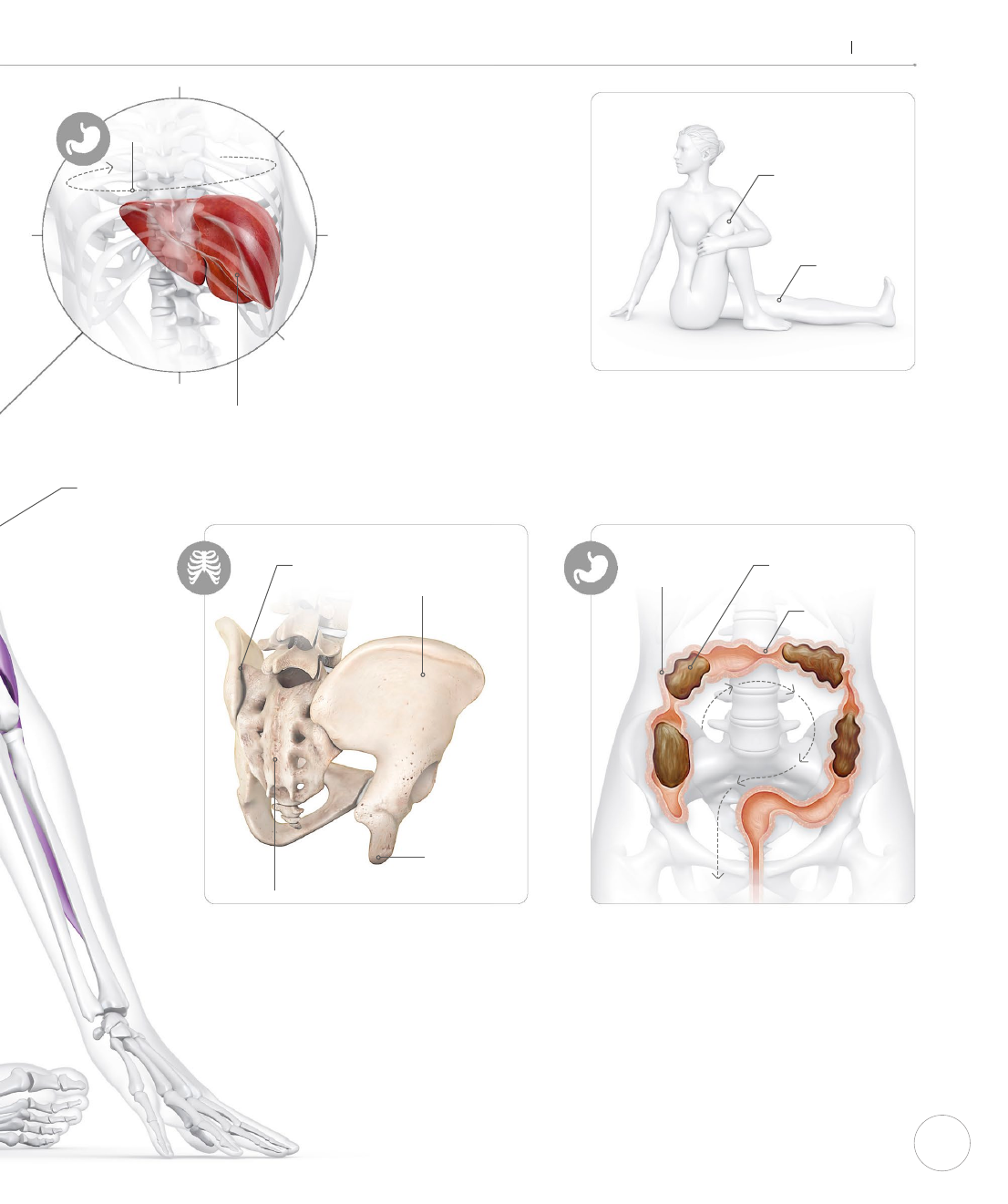
68
ALIGNMENT
Prioritize elongating your spine
over rotating more or leaning.
If you do decide to rotate more
deeply, try to use your core
muscles instead of pulling with
the external force of your arms.
Arm presses
down
Spine elongating
Keep the rotation
as even as possible
Pelvis rotates
slightly with you
THE ASANAS Seated
This seated twist will wake up small muscles along
your spine and stimulate digestion. Practicing twists
mindfully in yoga can help prevent injury from twists
you do in everyday life. Take care not to twist too far
if you have spinal disk issues or osteoporosis.
THE BIG PICTURE
Your back muscles and abdominals
dynamically engage and stretch as you
rotate your spine. Your thighs and hips—
particularly around your buttocks—are
stretching as they rotate outward. Your
lowered arm presses down to help you
find more length along your spine.
SEATED TWIST
Ardha Matsyendrasana
Neck
To rotate your neck, on the
contralateral side of axial rotation (side
you are rotating away from, model’s left
side on this image), your rotatores,
multidus, sternocleidomastoid, and
semispinalis cervicis engage while
stretching on the ipsilateral side (the
side you are rotating toward). Your
splenius capitis and splenius
cervicis engage on the ipsilateral
side, and stretch on the contralateral.
Arms
On your extended arm, your
teres minor engages to
stabilize and externally rotate
your shoulder, while your teres
major extends your shoulder.
Your elbow exors and triceps
are dynamically engaging to
help hold your arm in place,
pushing down into the ground
to help elongate your spine. On
your exed arm, your elbow
exors engage while your
triceps stretches slightly.
Sternocleidomastoid
Biceps brachii
Brachioradialis
Elbow
Shoulder
Teres major
Teres minor
Triceps brachii
Brachialis
KEY
Joints
Muscles
Engaging
Engaging while
stretching
Stretching
US_068-069_Seated_twist_01.indd 68 20/09/2018 20:46

69
Torso
On the contralateral side of
axial rotation (this model’s left),
your external abdominal
obliques engage, while your
internal abdominal obliques
stretch. On the ipsilateral side,
your internal abdominal
obliques engage while your
external obliques stretch. Your
spinal extensors engage on
both sides—including your
erector spinae and quadratus
lumborum muscles.
Thighs
In your top thigh, your gluteus
maximus, tensor fasciae latae,
iliotibial band, and quadriceps
stretch. In your bottom thigh,
you may feel most of the stretch
in your quadriceps.
Knee
Hip
Gluteus maximus
Gluteus medius
Iliopsoas
Vastus lateralis
Rectus femoris
Vastus medialis
Iliotibial band
Sartorius
Spine
Quadratus lumborum
External obliques
Erector spinae
Transversospinalis
Serratus anterior
US_068-069_Seated_twist_01.indd 69 20/09/2018 20:46

70
SEATED TWIST
Ardha Matsyendrasana
CLOSER LOOK
Spinal twists aect the disks between your vertebrae
and your sacroiliac joint. Although this action may
not “wring out toxins” as is sometimes claimed,
it does encourage healthy digestive movement in
your intestines, known as peristalsis.
Spinal rotation
With rotation of your spine (spinal twists), your
intervertebral disks naturally compress. For optimal safety
and benet, rst consciously lengthen your spine into
axial extension as much as possible, then twist only as far
as your muscles bring you. Use your arms to help you
maintain length in your spine. Breathe.
Small, deep muscles
called rotatores help
to rotate your spine
Intervertebral
disks compress
Vertebrae rotate
Gluteal muscles
stretch
Foot is relaxed
External obliques
engage as you
twist away
US_070-071_Seated_twist_02.indd 70 25/09/2018 17:03

71
THE ASANAS
Seated
Sacroiliac joint
Allow your sitting bones to move slightly on the oor
with the twist. If you anchor them down, the twist puts
a lot of pressure on the structure of the SI joint, which
can cause aches. Alternatively, allowing too much
movement in your SI joint can also lead to achiness.
Find the middle way for your body.
Contracted
muscle
Relaxed
muscle
Stimulating peristalsis
In your digestive tract, peristalsis is the involuntary
engagement of smooth muscles to move digesting food
(see p.39). Thankfully, you don’t have to consciously tell
your stomach to empty into the small intestines. Stress
and a sedentary lifestyle can aect peristalsis and lead to
digestive issues. Twisting can stimulate healthy peristalsis.
Wringing out toxins
You may have heard that
spinal twists “wring out toxins.”
However, your liver eciently
deals with toxins automatically.
Although mechanically
compressing the organs may
be benecial, evidence does
not show that this contributes
to “detoxication.” You can
instead visualize wringing out
negative energy as you twist,
for psychological benet.
Your liver naturally
detoxifies
Rotation of torso
VARIATION
For a gentler twist, keep one leg extended
and consider not crossing the lifted leg over
the midline. Use your arm wrapped around
the leg to help you sit tall as you twist.
Ilium
Sacroiliac
joint (SI)
Ischial
tuberosities
(sitting bones)
Food moving through
the digestive tract
POSTERIOR–LATERAL VIEW
Leg not
crossed over
Knee
extended
Sacrum
Deep to the
erector spinae,
the multifidus is
dynamically engaging
US_070-071_Seated_twist_02.indd 71 25/09/2018 17:03
..................Content has been hidden....................
You can't read the all page of ebook, please click here login for view all page.
